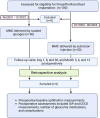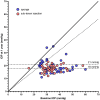One-Year Comparison of Efficacy and Safety of PreserFlo MicroShunt with Mitomycin C Applied by Sub-Tenon Injection Versus Sponge
- PMID: 39576486
- PMCID: PMC11724825
- DOI: 10.1007/s40123-024-01074-y
One-Year Comparison of Efficacy and Safety of PreserFlo MicroShunt with Mitomycin C Applied by Sub-Tenon Injection Versus Sponge
Abstract
Introduction: This study was performed to compare the efficacy and safety of PreserFlo MicroShunt (PMS) implantation with mitomycin C (MMC) applied by sub-tenon injection versus conventional application by MMC-soaked sponges.
Methods: This retrospective, 1-year cohort study included 100 eyes of 100 patients with glaucoma who underwent PMS implantation with MMC (0.4 mg/ml) delivered either by sub-tenon injection (50 eyes) or via soaked sponges (50 eyes). The primary outcome measure at 1 year was intraocular pressure (IOP) reduction, with complete success defined as an IOP reduction of ≥ 20% and achieving a target IOP of ≤ 21 or 18 mmHg without the use of medication. Secondary outcomes, including corneal endothelial cell density (CECD) loss, the number of medications, and complications, were assessed and compared between the groups.
Results: Sustained reductions in mean IOP were observed in both groups over the 1-year follow-up, with no significant differences between the groups. The complete success rate, with a target IOP of ≤ 21 mmHg after 1 year, was 19.3% in the sponge group and 26.4% in the injection group. The qualified success rate was 59.0% and 87.4% in the sponge and injection groups, respectively. A longer survival rate was observed in the injection group than in the sponge group when IOP was below 21 mmHg. The mean CECD significantly decreased (P < 0.01) from baseline to each postoperative follow-up time point in both groups. At 1 year postoperatively, the percentage of total CECD loss was 8.1% in the sponge group and 8.0% in the injection group. However, no significant differences in mean CECD values, the number of medications, or adverse events were found between the groups.
Conclusions: PMS implantation with sub-tenon injection of MMC was comparable in terms of efficacy and safety to traditional MMC delivery via soaked sponges. However, the injection group demonstrated a significantly higher success rate than the sponge group.
Keywords: Corneal endothelial cells; Glaucoma; Glaucoma surgery; Intraocular pressure; MIBS.
© 2024. The Author(s).
Conflict of interest statement
Declarations. Conflict of Interest: Nora Majtanova and Petr Kolar have the following financial disclosures: Alcon (honorarium); Santen (consultancy and honorarium) and Bayer (honorarium). Adriana Takacova has the following financial disclosures: Alcon (honorarium) and Santen (honorarium). Veronika Kurilova, Libor Hejsek, and Juraj Majtan have no competing interests. Ethical Approval: The study was conducted according to the guidelines of the Declaration of Helsinki and approved by the Institutional Review Board of St. Cyril and Method University Hospital No. 1/9/20/24. Informed consent for surgical procedure was obtained from all subjects involved in the study.
Figures







Similar articles
-
One-Year Randomized Comparison of Safety and Efficacy of Trabeculectomy with Mitomycin C Sub-Tenon Injection versus Mitomycin C-Infused Sponges.Ophthalmol Glaucoma. 2022 Jan-Feb;5(1):77-84. doi: 10.1016/j.ogla.2021.05.006. Epub 2021 May 28. Ophthalmol Glaucoma. 2022. PMID: 34058431 Clinical Trial.
-
Treatment Outcomes of Mitomycin C-Augmented Trabeculectomy, Sub-Tenon Injection versus Soaked Sponges, after 3 Years of Follow-up: A Randomized Clinical Trial.Ophthalmol Glaucoma. 2018 Jul-Aug;1(1):66-74. doi: 10.1016/j.ogla.2018.06.003. Epub 2018 Jul 6. Ophthalmol Glaucoma. 2018. PMID: 32672635 Clinical Trial.
-
A Comparison of Trabeculectomy Surgery Outcomes With Mitomycin-C Applied by Intra-Tenon Injection Versus Sponge.Am J Ophthalmol. 2020 Aug;216:243-256. doi: 10.1016/j.ajo.2020.03.002. Epub 2020 Mar 12. Am J Ophthalmol. 2020. PMID: 32173343
-
Comparison of Methods to Deliver Mitomycin C in Trabeculectomy Surgery: A Systematic Review and Meta-Analysis.Ophthalmol Glaucoma. 2025 Apr 19:S2589-4196(25)00072-9. doi: 10.1016/j.ogla.2025.04.004. Online ahead of print. Ophthalmol Glaucoma. 2025. PMID: 40254063 Review.
-
Efficacy and safety of intraoperative injection of mitomycin C during trabeculectomy: a systematic review and meta-analysis.Int Ophthalmol. 2024 Sep 6;44(1):372. doi: 10.1007/s10792-024-03291-7. Int Ophthalmol. 2024. PMID: 39240391
References
LinkOut - more resources
Full Text Sources

